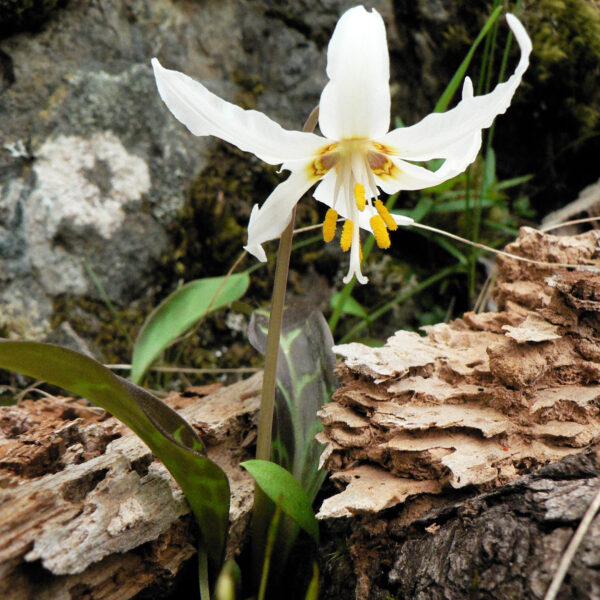White Fawn Lily
Erythronium oregonum Appleg. ssp. oregonum

overview
Perennial herb from a narrowly egg-shaped, 3-5 cm long bulb and an elongate, segmented corm; flowering stems 15-35 cm tall, smooth. Leaves: Basal leaves 2, dull dark-green mottled with brown and white or pale green, lanceolate to oblong-elliptic, 10-20 cm long, smooth, abruptly narrowed to short, broad, somewhat winged stalks, the margins entire but often somewhat wavy; stem leaves lacking. Flowers: Inflorescence of one, sometimes two or three, flowers atop a leafless, unbranched, smooth stem; flowers white with some yellow or orange at the base on the inner surface, nodding, of six similar, distinct, petal-like segments (tepals), the tepals broadly lanceolate, 3.5-5 cm long, curved back; six stamens, anthers white or yellow; one three-chambered pistil. Fruits: Capsules, broadly club-shaped, erect, 3.5-5 cm long; seeds several to many, brown, egg-shaped, angular (Douglas et al., 2001). Photo by Rob Hagel.
family
Liliaceace
ecological setting
Dry to mesic meadows in open forests in the lowland zone (Douglas et al., 2001); Open, often grassy areas, open to fairly dense rocky woodlands (Pojar and Mackinnon, 1994); Common in meadow-like communities and open-canopy forests on well-drained sites (Klinka et al., 1989).
soil texture
Rocky (Pojar and Mackinnon, 1994)
nutrients
Nitrogen-medium soils (Klinka et al., 1989).
moisture regime
Well-drained (Pojar and Mackinnon, 1994); Moderately dry to moderately moist soils (Klinka et al., 1989).
shade tolerance
Shade-intolerant (Klinka et al., 1989)
landscaping
Excellent groundcover once established and mixed with native grasses; also for rockeries (S. Bastin, pers. comm.).
flowering time
March-April
fruit ripening time
July-August
seed collection time
July-August
crop intervals
Annual to semi-annual.
collection and abstraction
Hand pick ripe seed capsules into collection bags and shake to release the seeds.
seed storage
Store in sealed containers at 5º C.
fruit seed dormancy treatment
Sow seeds into nursery flats in the fall. Place flats in soil in a semi-shady or shady spot. Seeds usually have a high germination rate. Keep containers in place for three to five years until bulbs grow large enough to support flowering. Do not move or repot seedlings in early years. Alternatively, sow seeds into well-prepared nursery bed in fall.
vegetative propagation
Not recommended.
additional info and photos
For more information and pictures, visit the E-Flora BC website at www.eflora.bc.ca.